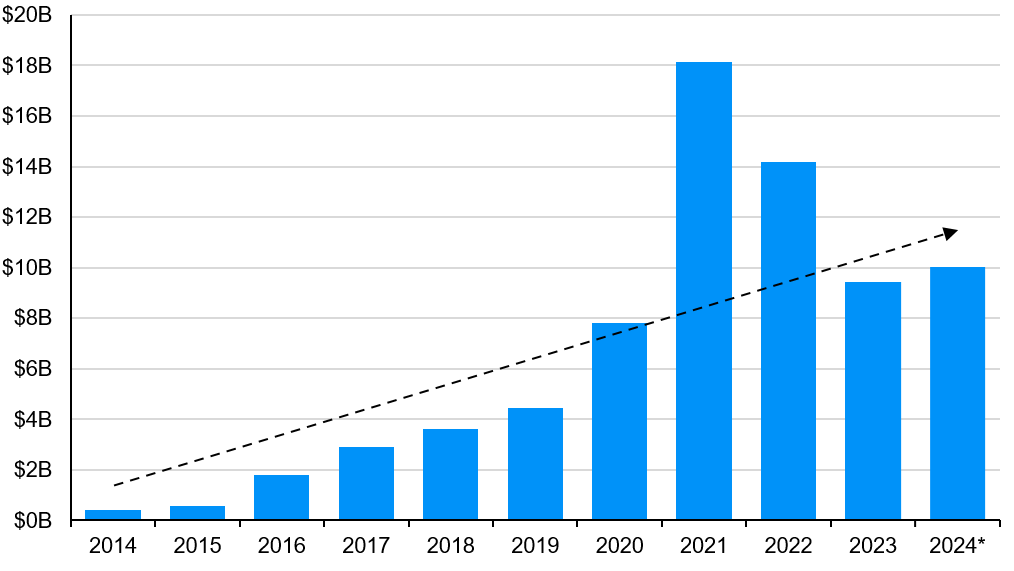Written by: Stephanie Aliaga
Despite great accomplishments in medical treatments over the years, innovation in the healthcare industry has long been plagued by analog data storage, inaccessible solutions and impersonalized patient treatments. This is now rapidly changing, with AI technologies driving significant advancements in various aspects of the industry.
1. Enabling the use of massive volumes of relatively unstructured health data
Despite comprising over one-third of the world’s total volume, data in healthcare has historically been siloed and poorly organized, with over 80% unstructured.[1]However, over the past 15 years, tens of billions of dollars have been spent to digitize the industry (i.e. via electronic health records), allowing AI models to harness the over 500 petabytes of health-related data that exist today.[2]
2. Reducing the cost and timeline of drug discovery and development
Drug development is a lengthy and costly process. It can take up to 18 years from pre-clinical research to commercialization and costs an average of $2.3 billion per drug[3]—of which 80%, on average, is spent on R&D. By boosting productivity, generative AI could cut costs while improving drug success rates. McKinsey estimates a potential increase of $60-110 billion in annual economic value for pharma and medical product industries.
For instance, Phase III clinical trials (the final step before FDA approvals) are comprehensive and capital intensive. Such trials for Eli Lilly and Novo Nordisk’s obesity drugs lasted an average of 68-72 weeks across 1,000-2,500 obese patients (which tend to take 6-10 months to enroll). Altogether, costs could reach as much as $50 million for a single study.[4] Meanwhile, an AI-enabled company like QuantHealth can take clinical trial simulations to the cloud, where they can predict how an entire clinical trial would play out with 86% accuracy, ultimately allowing for optimized trial design and more “shots on goal” to bring drugs to patients quicker.[5]
3. Contributing to next-generation science
Generative learning models can also help unlock novel biological insights and solutions. Just like ChatGPT can predict the next word in a sentence, AI models are predicting molecular structures. For instance, Google's AlphaFold can accomplish what used to take scientists years and millions of dollars in just a few hours and at minimal cost. In 2021, scientists had only determined 20% of existing protein structures. Today, the Institute for Cancer Research reports that 99% of known proteins have been mapped.[6] With enhanced understanding of protein structures, scientists can more effectively curate medications for many disease types, advance drug development and biological research.
4. Narrowing the critical shortage of healthcare workers
The aftershock of the global pandemic has left the industry with a critical shortfall of healthcare professionals[7]–but AI is helping narrow this gap. Telehealth is stepping in where physical access is prohibitive, while advances in wearable or implanted devices are enabling continuous health monitoring, reducing the need for in-person doctor visits (or prompting them when needed). Some private companies are also building virtual “doctors” powered by large language models[8], enhancing the scalability and personalization of care.
There are still hurdles to overcome in bringing many of these use cases to practical, broad-scale use. For instance, data quality is of particular emphasis in health applications, highly sensitive patient data require robust security and integration can face regulatory barriers. Given healthcare’s known complexities, the leading companies are more likely to be vertical-specific and guided closely by deep healthcare experts who can help navigate these hurdles.
However, for investors looking to diversify concentration to U.S. tech names or to lean into underappreciated AI beneficiaries, the vast healthcare market provides a diverse set of opportunities in both public and private markets. An emphasis on profitability will be needed, but well-positioned investors could take advantage of the new era unfolding in healthcare transformation.
Growth in VC-backed healthcare AI investments
Capital invested in healthcare AI/ML companies

Source: Pitchbook, J.P. Morgan Asset Management. Considers companies tagged as healthcare and AI/ML. *2024 is annualized for full year numbers. Data are as of February 28, 2024.
[1] Gopal Srinivasan et al., 2023, “A new frontier in artificial intelligence: Implications of Generative AI for business,” Deloitte.
[2] For context, 1 petabyte of music files would constitute over 300 million songs.
[3] Deloitte. Annual Pharmaceutical Innovation Report (2023)
[4] Piper Sandler, “Obesity is on Fire; What Does It Take to Standout in A Competitive Market?” April 1, 2024.
[5] Accenture, January 2024. QuantHealth's Clinical-Simulator predicts how each patient in a clinical trial will respond to treatment, allowing trial design teams to predict how an entire clinical trial will play out, and optimize trial design.
[6] As we discussed in our paper, “The transformative power of generative AI”, this is one of the most exciting use cases of non-generative AI. Prior to Google’s AlphaFold, scientists had only determined the structure of 17% of proteins. AI is now predicting the complex folding structure of protein with unprecedented accuracy in minutes. With enhanced understanding of protein structures, scientists can more effectively curate medications for all sorts of diseases, advancing drug development and biological research.
[7] Boniol M, Kunjumen T, Nair TS, et al. “The global health workforce stock and distribution in 2020 and 2030: a threat to equity and ‘universal’ health coverage?”, BMJ Global Health 2022.
[8] See for instance, Hippocratic AI.
Related: Corporate Bonds: Constructive or Cautious? Evaluating Investment Approaches Amid Yields and Spreads


